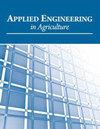基于人工神经网络的农用轮胎三维足迹与牵引力关系研究
IF 0.9
4区 农林科学
Q4 AGRICULTURAL ENGINEERING
引用次数: 1
摘要
拖拉机牵引力的改进提高了田间效率。拖杆拉力随轮胎足迹长度增加而增加。拖杆拉力随轮胎足迹体积和深度的增加而减小。2D占用空间不包含的3D占用空间参数会显著影响拉拔杆的拉力。摘要提高农用拖拉机在田间的牵引力,可以提高农用拖拉机的工作效率和能力。繁重的工作,如犁地,需要高水平的轮胎打滑,当需要传递拉杆拉力时,这与功率损失直接相关。因此,可以假设具有更高牵引能力的轮胎可以提高机器的工作效率。测量轮胎几何参数的自然演变导致考虑三维足迹,因为土-轮胎界面处的垂直应力分布可能是高度不均匀的。本研究将10组轮胎的三维足迹数据与相同轮胎在不同滑移比的土壤地形上进行的拉杆试验数据进行了处理。随后,基于人工神经网络的人工智能多元方法实现了牵引力预测,并验证了获取的几何参数对实测牵引力的重要性。该研究证实了3D轮胎足迹的几何参数与牵引力的相关性,人工智能建模的结果强调了这些收购的影响。然而,需要进一步的工作来考虑不同的凸耳几何形状,以扩展所研究方法的普遍性。关键词:田间效率;酚醛树脂;牵引机;本文章由计算机程序翻译,如有差异,请以英文原文为准。
Relationship between the 3D Footprint of an Agricultural Tire and Drawbar Pull Using an Artificial Neural Network
HighlightsImprovement of tractor traction provides better field efficiency.Drawbar pull increased with tire footprint length.Drawbar pull decreased with increasing tire footprint volume and depth.3D footprint parameters, which the 2D footprint do not contain, affected the drawbar pull significantly.The ANN highlighted the relation adequately.Abstract.Improving the traction of an agricultural tractor on the field increases its working efficiency and capacity. Heavy work, like plowing, entails high levels of tire slip, which is directly related to power loss when the transmission of drawbar pull is required. Accordingly, it is possible to hypothesize that a tire with a higher traction capability could increase the working efficiency of the machine. The natural evolution for measuring the geometrical parameters of tires has led to the consideration of three-dimensional (3D) footprints since the distribution of the vertical stresses at the soil–tire interface may be highly non-uniform. In this study, the data acquired from 3D footprints of 10 sets of tires underwent processing along with the data from drawbar tests carried out with the same tires on soil terrain at different slip ratios. Subsequently, artificial intelligence multivariate methods based on artificial neural networks allowed traction prediction and verified the importance that the acquired geometrical parameters have on the measured drawbar pull. The study confirmed the correlation of the geometrical parameters of the 3D tire footprint with the drawbar pull and the results of the artificial intelligence modelling underlined the impact of these acquisitions. However, further work that considers various lug geometries is required to extend the generalizability of the studied methodology. Keywords: Field efficiency, Phenolic resin, Traction, Tractor.
求助全文
通过发布文献求助,成功后即可免费获取论文全文。
去求助
来源期刊

Applied Engineering in Agriculture
农林科学-农业工程
CiteScore
1.80
自引率
11.10%
发文量
69
审稿时长
6 months
期刊介绍:
This peer-reviewed journal publishes applications of engineering and technology research that address agricultural, food, and biological systems problems. Submissions must include results of practical experiences, tests, or trials presented in a manner and style that will allow easy adaptation by others; results of reviews or studies of installations or applications with substantially new or significant information not readily available in other refereed publications; or a description of successful methods of techniques of education, outreach, or technology transfer.
 求助内容:
求助内容: 应助结果提醒方式:
应助结果提醒方式:


